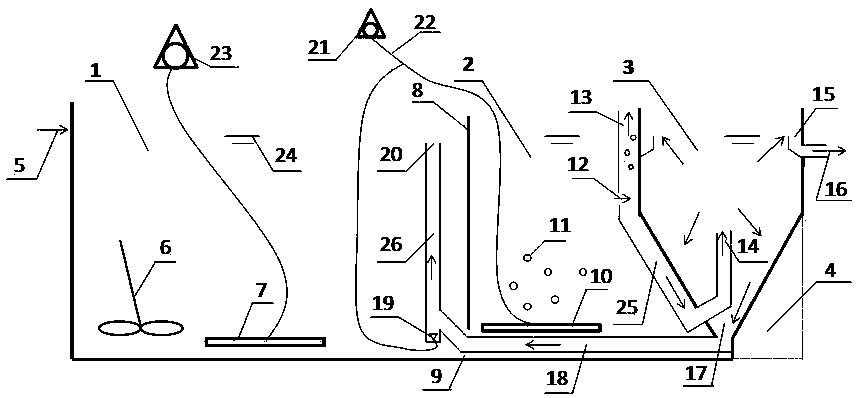Method and apparatus for depth nitrogen and phosphorus removal from small-flow sewage
A deep denitrification, small flow technology, applied in chemical instruments and methods, water/sewage multi-stage treatment, water/sludge/sewage treatment, etc. Complex problems, etc., to achieve high-flow sludge return, reduce aeration energy consumption, and reduce the size of the reactor
- Summary
- Abstract
- Description
- Claims
- Application Information
AI Technical Summary
Problems solved by technology
Method used
Image
Examples
Embodiment 1
[0035] figure 1 It is a structural schematic diagram of a device for deep denitrification and dephosphorization of sewage with small flows according to the present invention. Such as figure 1As shown, a device for deep denitrification and dephosphorization of sewage with a small flow rate includes a reaction tank, a sedimentation tank 3 and a control device 4. The reaction tank is provided with a partition 8 to divide the reaction tank into aeration / The stirring alternate zone 1 and the oxygenation zone 2, the bottom of the sedimentation tank 3 is funnel-shaped, the bottom is provided with a sedimentation tank mud bucket 17, the upper part of the sedimentation tank 3 is provided with a sedimentation tank outlet weir 15; the aeration / stirring alternate zone 1 is equipped with The first aeration device and the stirring device 6, the oxygenation zone 2 is provided with the second aeration device, and the control device 4 is connected with the first aeration device, the stirring...
Embodiment 2
[0044] An example of deep denitrification and dephosphorization of domestic sewage by using the device described in Example 1. Using conventional domestic sewage, the treated water volume is about 50 tons / day. Influent water quality characteristics: COD~350 mg / L, TSS~150 mg / L, TN~29 mg / L, ammonia nitrogen~18 mg / L, TP~3.8 mg / L. Control parameters: the alternating area is controlled to aerate for 1 hour each time, and then stir for 1 hour. During aeration, the dissolved oxygen is controlled at about 2 mg / L, the hydraulic retention time of the alternating area is about 10 hours, and the hydraulic retention time of the oxygenation area In about 2 hours, the water temperature is about 20 degrees.
[0045] After the system is stabilized, after a one-month follow-up test, the average concentration of effluent pollutants is: COD~25 mg / L, TSS~9.4 mg / L, TN~8.2 mg / L, ammonia nitrogen~0.2 mg / L, TP ~0.4 mg / L, the effluent quality fully meets the first-class A standard in my country's "Pol...
PUM
 Login to View More
Login to View More Abstract
Description
Claims
Application Information
 Login to View More
Login to View More - R&D
- Intellectual Property
- Life Sciences
- Materials
- Tech Scout
- Unparalleled Data Quality
- Higher Quality Content
- 60% Fewer Hallucinations
Browse by: Latest US Patents, China's latest patents, Technical Efficacy Thesaurus, Application Domain, Technology Topic, Popular Technical Reports.
© 2025 PatSnap. All rights reserved.Legal|Privacy policy|Modern Slavery Act Transparency Statement|Sitemap|About US| Contact US: help@patsnap.com

